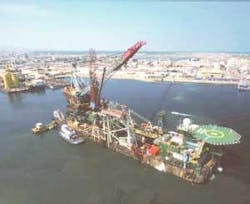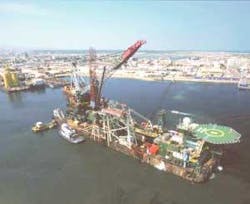WEST AFRICA:Linked field developments cut gas wastage off Niger Delta
Extensive upgrades planned
One of Stolt Offshore's more work-inten-sive shallow-water projects involves re-development of the Forcados Yokri oil and gas field in the Niger Delta. The centerpiece will be the largest produc-tion platform produced to date by its Warri-based Globestar yard.
The new complex will also be linked to Shell's offshore gas-gathering pipeline system (OGGS), which Stolt vessels are currently installing. Ultimately, this system will take gas from Bonga, EA, Yokri, and other fields to the Bonny Island LNG terminal. These two projects are worth $245 million net to Stolt, and they are also a lynchpin of Nigeria's policy of zero flaring by 2008.
Forcados Yokri is in Offshore Marine Lic-enses 43 and 45, across the mouth of the Forcados River. The project scope includes upgrades to 17 existing wellhead platforms and onshore facilities, and the addition of seven new platforms in water depths averaging 5-10 m. Work is being performed in concert with Nigerian contractor Suffolk, which is responsible for fabrication and installation of the smaller structures.
Paragon Litwin, a Stolt-owned engineering company in Paris, is contributing 150,000 hours of engineering work to this project, including detailed design of the production platform and topsides. All the platforms and bridge links are being manufactured in Warri, an exercise estimated to take 600,000 man-hours.
null
Development drilling started in fall 2001, and the whole project is scheduled for completion this December.
The existing installations were built by McDermott in the 1970s. Stolt Offshore is responsible for the refurbishment work, which includes installation of new risers and related activities. Prior to the current program, all the produced gas was either reinjected or flared. Gas reinjection will be increased under the new scheme. The new platforms will be very light jacket structures weighing between 80 and 300 tons, hosting one, three, or four christmas trees. They will be installed sequentially by Suffolk's parent company Adamac at the end of this year. These and the existing installations are also being equipped with power and optical fiber communications cables controlled remotely from the shore, on the North Bank of the river.
Weight constraints
The unmanned central prod-uction platform, an eight-month construction job, will comprise a 1,400-ton topsides and a six-leg, 450-ton jacket. The relatively light weight is dictated by the shallow water depth of 12 m. Topsides equipment will include four separation modules. The facility will be able to produce at a rate of 120,000 b/d.
A flat cargo barge will install the deck and jacket this June. The jacket will be launched from the Globestar quay at Warri into the river for subsequent tow to the offshore location and a floatover operation.
The topsides will be brought across and positioned using a modified version of Stolt's Smart Leg installation technique, based on monitored water jacks.
"Once the barge has been introduced onto the jacket, mating should be completed in less than one day," said Paragon Europe Offshore Division Director Raymond Brenas.
"We are operating in a protected area. Our main areas of concern are the strong currents, the spider's web of existing sea lines, and underlying involvement of the communities. Although the deck weight is within the lift capacity of the Seaway Polaris, we wanted to avoid the risk of this vessel being hijacked."
The project partners are also responsible for rehabilitating seven associated onshore wells and drilling two new ones, the latter managed by Adamac.
"No more offshore development wells are planned for the time being," Brenas said, "but in this area, there are several other gas/water injection platforms that could be refurbished. Shell may therefore decide to drill further wells shortly. The current program includes laying of 216 km of gas lift and gas gathering lines between the various installations, with some onshore sections. Some existing pipes are also being removed."
Last October, Stolt's LB200 barge started laying the 264-km, 32-in., trunkline (West Africa's longest to date) that will link Shell's new Nigerian field developments to the Bonny LNG plant. Later this year, the Polaris will lay spur lines between the Bonga riser platform and the Yokri/Tunu fields (90 km/24-in. diameter) and between South Forcados and the same platform (24 km/16-in. diameter). The Seaway Orion has already completed the difficult shore approach section.


